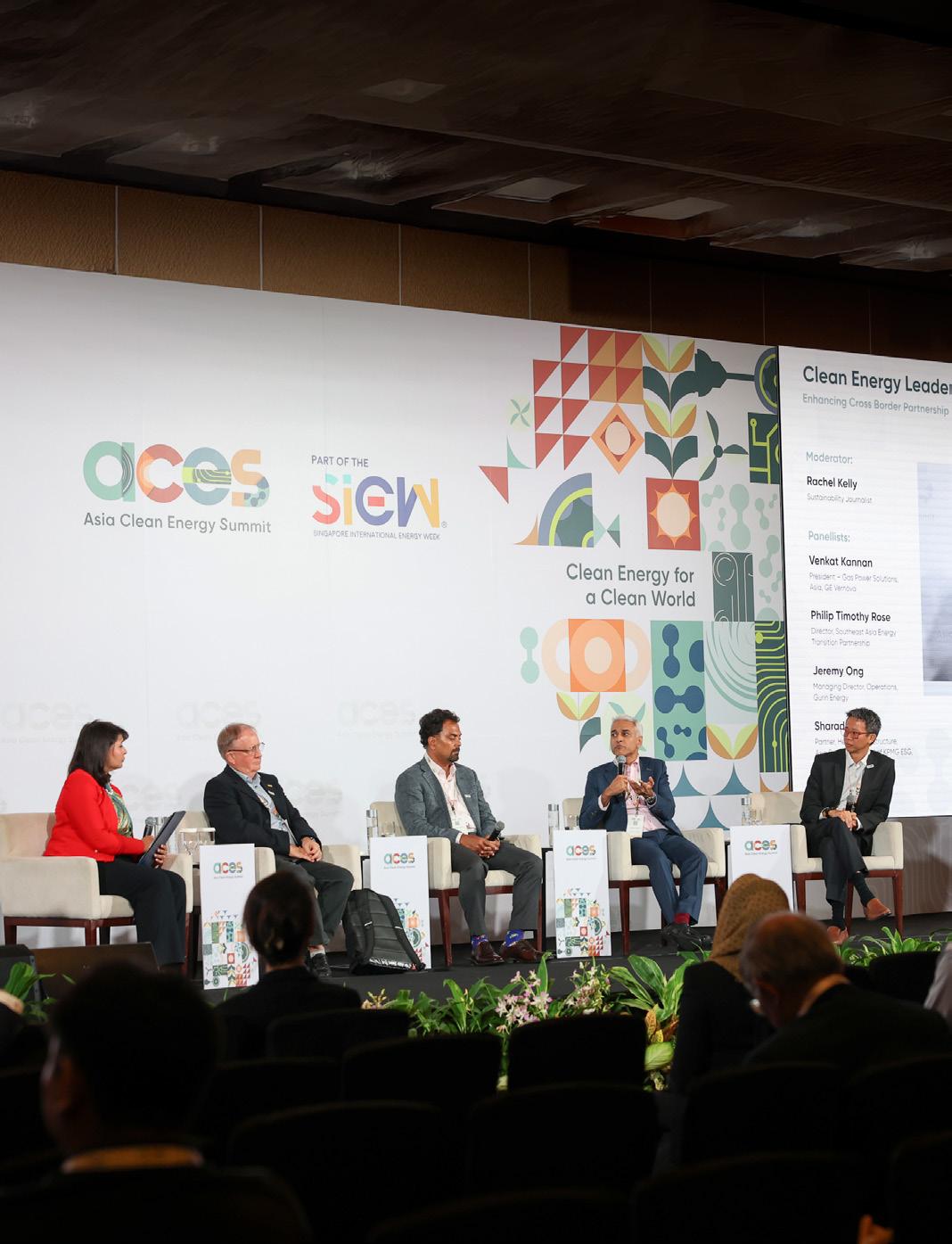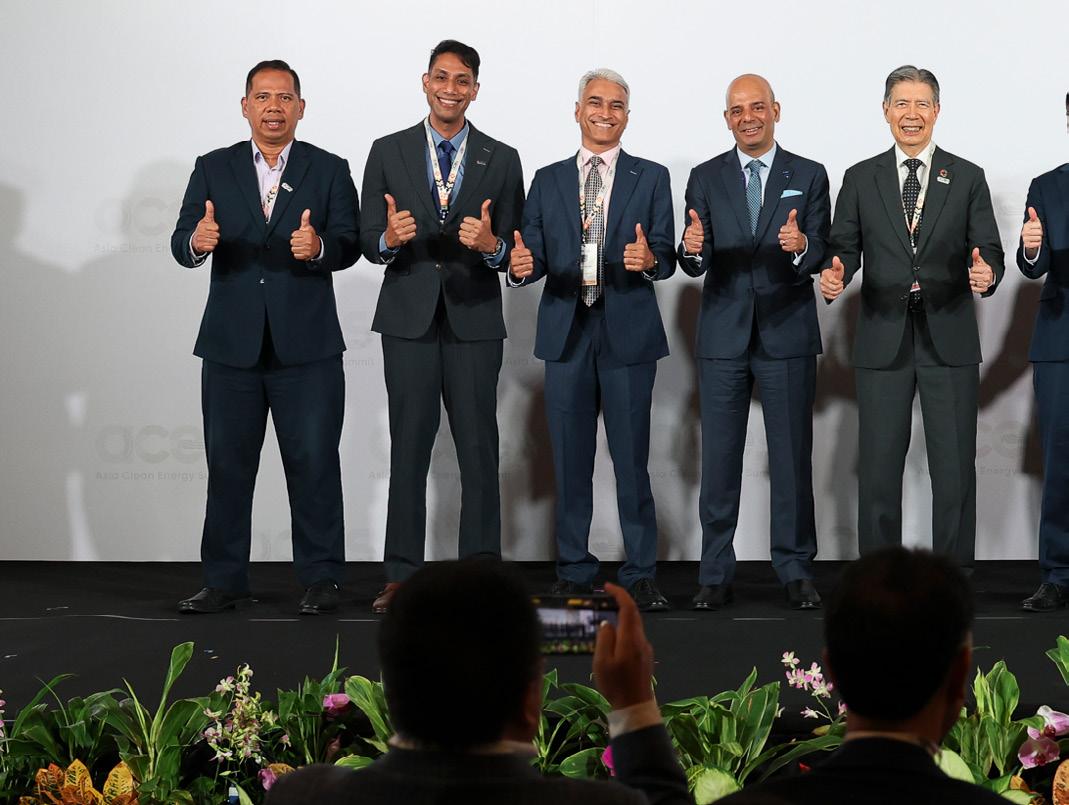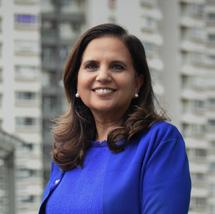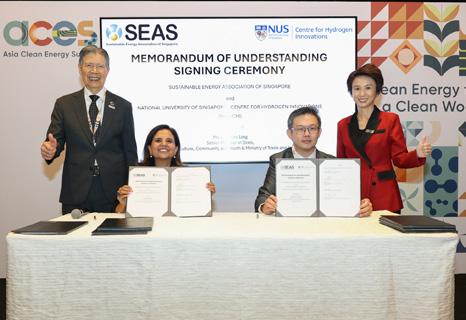


EMBRACING ENVIRONMENTAL INNOVATION














With robust renewable energy targets, Singapore is taking significant steps to reduce its carbon footprint, leading in innovation and adopting a strategic shift towards sustainability, whilst navigating the unique challenges posed by its geographic and climatic constraints
Writer: Rachel Carr | Project Manager: Joseph Perfitt
Situated at the southern tip of the Malay Peninsula in Southeast Asia, Singapore stands as a vibrant island city-state and a global beacon of modernity.
Renowned for its cutting-edge technology and striking contemporary architecture, the country has transformed from an obscure fishing village into a bustling metropolis where creativity thrives.
Presently, Singapore is undergoing another significant transformation as it moves into the sustainable energy landscape.
However, given its tropical climate – characterised by heat and humidity – Singapore faces unique challenges when it comes to energy generation.
The limited landmass and absence of shallow geothermal resources make it impractical to harness this type of energy, whilst the region’s generally low wind speeds render wind a less viable energy alternative.

In response to these issues, Singapore has adopted a forward-thinking strategy focused on R&D. The government and private sector are heavily investing in innovative technologies to enhance the efficiency and effectiveness of solar photovoltaic (PV) systems, aiming to capitalise on the abundant sunlight that graces the island.
Located near the equator, Singapore enjoys an average annual solar irradiance of 1,580 kilowatt-hours (kWh) per square metre (sqm) each year, ranking it amongst the world’s most solar-dense cities.
As of mid-2024, it had a grid-connected installed capacity of 1,348 megawatt-peak (MWp) of solar power, significantly bolstered by contributions from the private sector and public housing initiatives.
As such, solar PV is the nation’s most promising and feasible renewable energy source, and it is therefore rapidly expanding its solar energy capacity, targeting
at least two gigawatt-peak (GWp) by 2030 – enough to power around 350,000 households.
In addition, the government is investing in research to enhance solar technology and urban integration, including the development of floating solar panels for reservoirs.
As a built-up country with no rural hinterland, Singapore faces challenges in solar deployment, including limited land for large-scale installations and issues related to urban shading and high cloud cover.
As a result, the government is exploring solutions such as regional power grids and innovative energy technologies.
These initiatives aim to lower carbon emissions, which are the primary driver of energy consumption in Singapore.
Such efforts are encouraging the search for sustainable solutions that will pave the way for a greener future.


Kavita Gandhi, Executive Director of the Sustainable Energy Association of Singapore, shares insights into the organisation’s mission, challenges the country faces in its clean energy transition, and innovative initiatives fostering collaboration within the renewable energy sector
APAC Outlook (AO): Firstly, what are the origins of the Sustainable Energy Association of Singapore, its initial mission and vision, and current focus areas of the industry?
Kavita Gandhi, Executive Director (KG): The Sustainable Energy Association of Singapore (SEAS) was established in 2006 with the goal of providing a common platform for clean energy industry players, academia, and government stakeholders to collaboratively promote the adoption of sustainable energy.
Our initial mission was to support the growth of renewable energy companies in Singapore, with the vision of positioning the country as a regional hub for clean energy.
Today, SEAS focuses on accelerating the clean energy transition by supporting renewables, energy efficiency, e-mobility, green hydrogen, bioenergy, and carbon capture and storage services across the Association of Southeast Asian Nations (ASEAN).
We represent a growing network of over 250 member companies from across the sustainable energy value chain – including developers, solution providers, financiers, consultants, and educational institutions – who collectively advance clean energy deployment in the region.
AO: How does SEAS address the challenges Singapore faces as a resource-constrained country in fulfilling its energy requirements?
KG: As a country with limited natural resources and land, Singapore faces unique energy challenges.
SEAS works closely with government agencies and member companies to promote the development and deployment of innovative and efficient energy technologies. We actively engage in dialogues with policymakers to shape practical, forward-looking energy strategies.
Recognising our constraints, Singapore has embraced creative solutions such as deploying solar PV systems on rooftops, building façades, and floating platforms on reservoirs.
SEAS supports these efforts by facilitating industry collaboration, encouraging private sector innovation, and sharing best practices across our network.
Regionally, SEAS champions greater connectivity through cross-border renewable energy projects. A notable example is the Singapore Green Corridor Project, where several SEAS members are actively involved in

developing utility-scale solar and storage facilities in Indonesia to export clean electricity to Singapore.
This initiative not only supports Singapore’s climate goals but also opens up new markets and investment opportunities for our members across ASEAN.
Through such projects, SEAS continues to build capacity, strengthen partnerships, and advance regional energy resilience.

AO: What specific initiatives does SEAS support to foster collaboration amongst its members in the renewable energy sector?
KG: SEAS actively fosters collaboration through regular engagement platforms for our members.
We organise monthly committee and working group meetings across key focus areas, including clean energy, energy efficiency, sustainable infrastructure, and finance committees, as well as carbon, energy storage and mobility, hydrogen, and Sustainable Energy Start-Up Network (SESUN) working groups.
These committees and groups serve as platforms for dialogue, knowledge sharing, and networking opportunities amongst industry players.
Beyond these, we also organise industry roundtables, business missions, networking sessions, and knowledgesharing events to deepen partnerships and industry learning.
Our flagship event, the Asia Clean Energy Summit (ACES), is Southeast Asia’s premier clean energy platform, bringing together regional and international stakeholders to share insights, explore opportunities, and showcase innovations that are shaping the energy transition.


“OVER THE NEXT FIVE YEARS, WE ARE OPTIMISTIC ABOUT RAPID ADVANCES IN ENERGY STORAGE, DIGITALISATION, REGIONAL INTERCONNECTIVITY, AND CARBON SERVICES”
– KAVITA GANDHI, EXECUTIVE DIRECTOR, SUSTAINABLE ENERGY ASSOCIATION OF SINGAPORE
AO: Can you elaborate on the types of training courses offered in the SEAS Sustainable Energy Training Programmes?
KG: Since 2007, SEAS has been delivering high-impact training programmes both locally and internationally, aimed at advancing the renewable energy sector in Singapore and the region.
To date, SEAS has conducted over 710 courses, reaching more than 17,478 participants across the industry.
One of our flagship courses is the Singapore Certified Energy Manager (SCEM) programme. Designed for engineering professionals, SCEM equips participants with essential skills in energy audits, retrofitting, procurement, facility
and energy management, and energy engineering works.
To meet the growing needs of Singapore’s solar industry, SEAS also offers specialised training in rooftop and utilityscale solar PV systems, building-integrated photovoltaics (BIPV), and urban solar integration.
These courses are aligned with national deployment goals and talent development priorities. Additionally, we offer a comprehensive range of short courses and online modules that cover key industrial topics.
For organisations with specific learning needs, SEAS provides tailored in-house or hybrid corporate training programmes across areas like renewable energy deployment, green finance, carbon management, hydrogen, and e-mobility.
“As one of Singapore’s leading energy providers, we are committed to empowering communities with good choices—choices that are affordable, make sense, and care about the planet.” - Union Energy

Union Energy Reaffirms Regional Commitment to Renewable Energy with Bold Mission and Vision.
Under the leadership of CEO Ms. Ellen Teo, the company is doubling down on its regional efforts to make renewable energy accessible, affordable, and immediate.
“We’re bringing renewable energy to life. Not tomorrow, today. Not for some, for everyone,” said Ms. Ellen Teo, CEO of Union Energy Group.
Union Energy highlights three core values that shape its approach:
“Our mission is not just to provide clean energy—it’s to empower individuals and businesses to make better energy choices that benefit both their bottom line and the planet.”
With a focus on solar adoption and digital innovation, Union Energy is driving a new era of sustainable living, where clean energy solutions are no longer future aspirations but present-day essentials.
• Simplicity: Making adoption of renewable energy hassle-free through seamless, end-to-end solutions.
• Clarity: Communicating openly and transparently, enabling customers to make informed energy decisions aligned with their needs.
• Innovation: Driving sustainability by exploring strategic alliances and continuously evolving green energy solutions.


Union Energy’s expansion into Malaysia via Union Renewables marks a strategic move to support regional decarbonisation goals, while also tailoring energy solutions to local markets.
As one of Singapore’s most trusted energy providers with over 30 years of industry experience, Union Energy continues to lead by example—prioritising action, inclusion, and innovation in its pursuit of a greener future.
Corporate Identity: Pioneering a Renewable Energy Future
Union Energy is a leading force in Singapore’s clean energy transition, with core expertise in solar power and electric vehicle (EV) charging infrastructure. Our mission is to make sustainability accessible, practical, and impactful across both commercial and residential sectors.

EV: Ultra-Fast Charging for the Next Generation

Union Energy is a Licensed Charge Point Operator (CPO) under Singapore’s Land Transport Authority (LTA).
In partnership with Huawei EV Ultra Fast Megawatt DC Charger, we are contributing to the national roll out of 60,000 EV charging points with multiple charging hubs across the island.
Corporate Social Responsibility Commitment: Union for a Net Zero Energy Future Solar coupled with Union Battery Energy Storage System: At Union Energy, our technical approach to Corporate Social Responsibility is represented by our “Union Net Zero Energy Ecosystem”, a system of clean energy solutions and innovations that help reduce carbon emissions.
Another key part of our Corporate Social Responsibility efforts involves ongoing research and development into renewable energy sources and technologies. Our goal is to decarbonize the planet and restore environmental health.

The Huawei chargers will be among the 120 fast chargers to be installed at around 60 HDB carparks, including in Boon Lay, Redhill, Kallang Bahru, Tampines and Woodlands.
With these technological advances, Union Energy stands as the frontier leader to lead Singapore with usage of sustainable and clean energy for the residential landed property, commercial & industrial buildings.
With our expansion to Malaysia, we endeavor a positive impact in the sustainable energy industry in the region.
CONTACT US
Are you a commercial or residential property owner? Let Union Energy be your sustainability provider +65 858 5555 | enquiry@unionenergy.com.sg www.unionenergy.com.sg
https://www.unionenergy.com.sg/contact-us
All programmes are delivered by experienced industry practitioners, ensuring practical, relevant, and immediately applicable learning outcomes.
SEAS is also proud to lead the Sustainable Energy Centre of Excellence (SECOE), established in partnership with the Asian Development Bank (ADB).
SECOE serves as a regional platform to build capacity and transfer knowledge to government officials and industry leaders across Asia on sustainable energy policy, finance, and project development.
Since its inception in 2015, SECOE has trained 1,695 participants from 57 countries, thereby strengthening institutional capacity and accelerating the adoption of clean energy across the region.
In 2025, SEAS conducted two SECOE programmes –one in the Philippines and another in Indonesia – further supporting regional efforts to scale up sustainable solutions.
AO: What plans does SEAS have for expanding its training programmes to regional professionals outside the sustainable energy industry?
KG: We are actively expanding our training reach across Southeast Asia. We have launched regional programmes in partnership with multilateral organisations and development agencies, tailored for professionals in utilities, government, and industry.
Our goal is to empower more individuals across ASEAN with the knowledge and tools to accelerate the adoption of clean energy.
At ACES 2024, SEAS reached another milestone by signing a memorandum of understanding (MoU) with four leading institutes of higher learning – the National University of Singapore Centre for Hydrogen Innovations (CHI), Singapore Polytechnic (SP), Singapore Institute of Technology (SIT), and the Institute of Technical Education (ITE).

• Around 95 percent of Singapore’s electricity comes from natural gas which is the cleanest fossil fuel, emitting the least carbon per unit of electricity, significantly reducing the country’s carbon footprint. This represents a marked increase from just 19 percent at the beginning of the millennium.
• Solar, biomass, and municipal waste account for 4.3 percent of electricity generation, followed by coal at 0.9 percent, and petroleum products such as diesel and fuel oil at 0.4 percent.
• Singapore’s electricity is produced by the combustion of natural gas piped from Malaysia and Indonesia.
• The country also diversified its natural gas supply with the opening of a liquefied natural gas (LNG) terminal on Jurong Island, with future plans to build a second terminal to support new industrial sites and power plants.
AO: Finally, how does SEAS support its members in adopting sustainable practices and innovations, and how does it help members access new markets for renewable energy technologies?
KG: We support members in adopting sustainable business practices by providing timely policy updates, strategic advisory support, and exposure to the latest innovations in clean energy and low-carbon technologies.
We play an active role in connecting the supply and demand sides of the industry. This includes working with regional and sector-specific associations that represent large energy users, project developers, and technology adopters.
For example, SEAS recently organised industry roundtables with the semiconductor and data centre sectors to explore clean energy solutions tailored to their high energy demands and decarbonisation goals.
These kinds of sessions bring together solution providers from our membership with end-users to facilitate direct engagement and potential collaboration.


Founded in 2015, TRIREC is a Singapore-based venture capital firm on a clear mission to accelerate global decarbonisation through strategic early-stage investments. Our journey began when our founders, Melvyn and Lawrence, backed Sunseap in its early days, supporting its growth from a young startup to its eventual acquisition by EDPR in 2022.
As first movers in the space, we have proudly made a name for ourselves, catalysing decarbonisation and driving impact early on – allowing TRIREC to work towards its vision of creating a climate-conscious world where the planet and business synchronously thrive.
We focus on five core verticals – energy, mobility, buildings, industries, and food and agriculture, investing in technologies that directly reduce or remove greenhouse gas emissions. With a global portfolio of over 20 companies, we typically invest at the Pre-Series A and Series A stages, targeting ventures that can scale and deliver meaningful change in decarbonisation. We are a pioneer in this space and emphasise being catalytic, helping founders navigate key inflexion points, and unlocking the next stage of growth.
We partner closely with mission-driven teams, providing more than just capital. We bring sector expertise, a strong network, and a deep commitment to positive outcomes. At TRIREC, we’re driven by the belief that accelerating decarbonisation not only benefits the planet but also creates long-term value and impact for all stakeholders.
TRIREC was the first to partner on a co-investment program with SEEDS Capital. Equally, we are a leader in the climate space in Singapore, having a curated network of investors and ecosystem partners to be part of the decarbonisation space and bridging the gap and facilitating connections.

TRIREC’s portfolio consists of a variety of influential and purposeful companies which work towards a better planet through TRIREC’s investments.
Sunseap, founded in 2011, is a Singapore-based clean energy solutions provider specialising in solar power generation and sustainable energy services across the Asia-Pacific region.
Having become a leading player in Southeast Asia’s renewable energy sector, with operations extending to countries including Vietnam, Cambodia, India, and Malaysia, the company has installed solar systems on over 1,500 public housing blocks in Singapore, producing enough clean energy to power approximately 42,000 four-room HDB households annually.
In parallel, Gush, founded in 2017, is a Singapore-based advanced materials company creating sustainable building solutions focused on wellness and decarbonisation. It’s signature air-purifying paints remove harmful VOCs and microbes, while its solar window films and thermal coatings reduce heat gain, lowering reliance on air conditioning.

Backed by proprietary catalyst technology, Gush’s products improve indoor air quality and energy efficiency without sacrificing design or scalability. With over 8,000 projects completed globally, Gush is driving the shift toward healthier, low-carbon living spaces, aligning itself with TRIREC’s mission and vision.
Headquartered in Singapore, Green Li-ion is a leader in sustainable lithium-ion battery recycling. It operates North America’s first commercial-scale facility in Atoka, Oklahoma, capable of producing battery-grade materials directly from unsorted battery waste.
Using cutting-edge, patented hydrometallurgical technology, the company recovers valuable materials, including lithium, nickel, cobalt, and graphite, helping to extend battery lifecycles and reduce electronic waste. By transforming used batteries into high-purity materials ready for reuse, Green Li-ion supports clean energy adoption, advances the circular economy, and contributes to global decarbonisation efforts.
At TRIREC, we are entrepreneurial at heart, collaborative by nature, guided by integrity, and driven to succeed.
AO: Are there any projects, events, or key initiatives you would like to highlight?
KG: SEAS is proud to lead several flagship initiatives that advance the clean energy transition in Singapore and the wider region.
Held annually as part of the Singapore International Energy Week (SIEW), ACES is Southeast Asia’s leading clean energy platform.
It brings together policymakers, industry leaders, and financiers to explore the latest developments in renewable energy, energy efficiency, and clean technologies.
ACES features a high-level conference and exhibition, along with networking opportunities designed to foster regional collaboration and cooperation.
Launched alongside ACES, the Asia Carbon Summit is a dedicated platform focused on carbon markets and decarbonisation strategies. It convenes key players from the public and private sectors to discuss regulatory frameworks, market mechanisms, and corporate action in support of net zero goals.
In addition, launched at the Asia Clean Energy Summit 2024, DigiLeap is a SEAS-led initiative designed to accelerate sustainability and decarbonisation efforts across ASEAN.
Designed as a comprehensive one-stop hub, DigiLeap connects businesses, financial institutions, and trade associations, fostering collaboration and innovation in the green economy.
To date, DigiLeap has recorded 231 engagements and attracted 196 project interests, resulting in 15 successful project matches between companies.
It has also drawn 408 users comprising 239 companies and 169 individuals, underscoring SEAS’s role in building an active and connected ecosystem for clean energy innovation and implementation.



AO: How do you see the sustainable energy industry developing over the next five years? Are you optimistic about its future?
KG: Despite current geopolitical and economic turmoil, SEAS aims to be a recognised leader in the sustainable energy sector, continually expanding its regional and global partnerships to create value for our members.
Over the next five years, we are optimistic about rapid advances in energy storage, digitalisation, regional interconnectivity, and carbon services.
As climate targets become increasingly stringent and the demand for clean energy intensifies, Singapore and ASEAN are well-positioned to lead through innovation and collaboration.
We will continue to engage members actively through committees and working group meetings, as well as various activities, serving as a bridge to connect members with relevant government agencies and facilitate local and global business growth.

Ph. +6563388578 info@seas.org.sg www.seas.org.sg




“At JJ-LAPP, sustainability is not a trend—it’s a responsibility woven into our business strategy. Our early commitment to carbon neutrality in 2011 reflects our belief that progress must be purposeful. Today, we are proud to empower clean energy projects, not only by delivering safe and reliable solar solutions but by actively partnering with customers to drive real impact on the ground. From the cables we manufacture to the support we provide on-site, every action we take is guided by our mission to build a greener, safer, and more resilient energy future.”
— Hanis Koh, General Manager, JJ-LAPP
JJ-LAPP’s sustainability journey began with that bold step in 2011, becoming the first industrial company in Southeast Asia to achieve carbon neutrality. Since then, our efforts haven’t slowed—we’ve continued to shape the clean energy landscape with long-term partners like Huawei, providing end-to-end solar and energy storage solutions
Huawei contributes cutting-edge technologies. We bring onthe-ground technical support, customer-first service, and a commitment to safety. Together, we help customers not just adopt solar—but succeed with it.
JJ-LAPP supports some of Singapore’s most impactful clean energy initiatives: the JTC Solar Initiative, SolarNova Programme, floating solar projects, and Energy Storage Systems (ESS). These projects are not only helping businesses reduce emissions—they’re contributing to Singapore’s national energy goals.
Safety is non-negotiable in every solution we offer. Huawei’s inverters feature AFCI (Arc Fault Circuit Interrupter) and RSD (Rapid Shutdown)—providing early fault detection and emergency shutdown capabilities. Their Battery Energy Storage System (BESS) holds the highest TÜV certification, offering industry-leading protection.
Our LAPP cables are engineered to perform under the toughest conditions. From WP cables for freshwater applications to the H1 BUR cable for direct burial, all our products meet both EN and IEC standards. Quality, safety, and longevity are at the core of every connection we provide.
Case
During a dual-building solar project, a customer lost a critical communication connector just days before system activation. JJ-LAPP immediately located a spare in our warehouse and hand-delivered it to site the same day—avoiding costly delays and proving our readiness to act when customers need us most.
Another project involved a curved roof and strict mounting restrictions. Our team visited the site, conducted testing, and worked closely with manufacturers to find a safe, effective solution. Even after the system was delivered, we stayed in touch to ensure smooth installation. That’s how we define partnership.
With a dedicated local technical team, JJ-LAPP supports customers from first consultation to post-installation check-ins. For us, clean energy is not just a product—it’s a promise we deliver every day.


